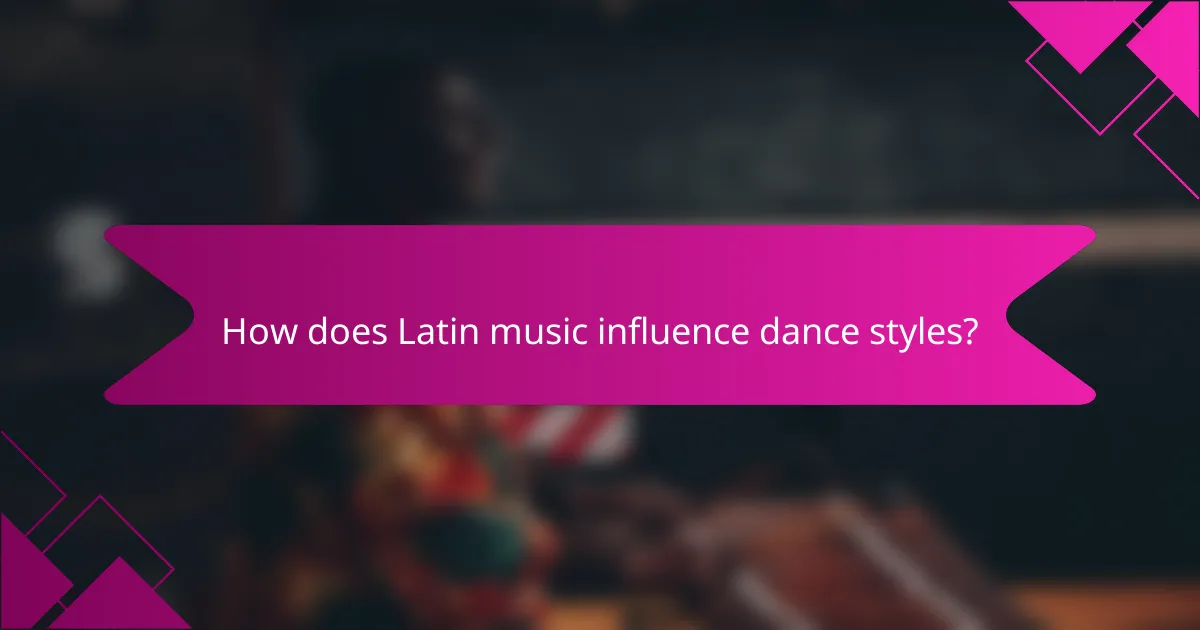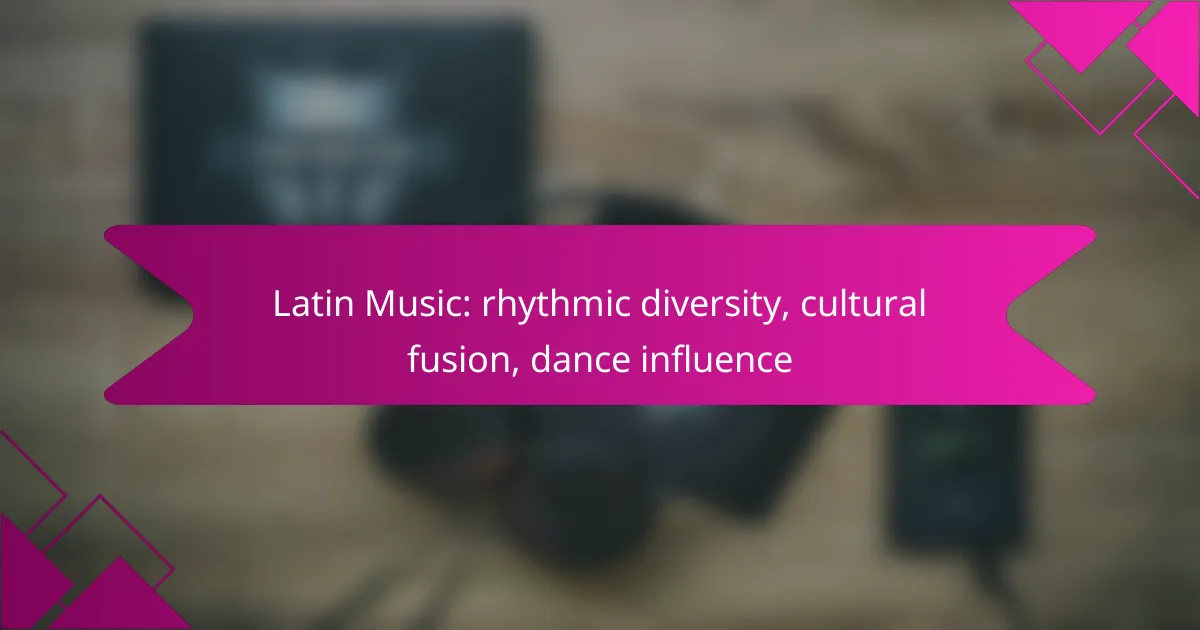Latin music is a vibrant tapestry of rhythmic diversity and cultural fusion, reflecting the rich heritage of Latin American countries. Genres such as Salsa, Bachata, Reggaeton, and Cumbia each bring unique sounds and influences, enhancing the expressive nature of dance. This musical landscape is shaped by the historical interplay of African, Spanish, and Indigenous traditions, resulting in dynamic rhythms that inspire movement and creativity.

How does Latin music influence dance styles?
Latin music significantly shapes various dance styles by providing distinct rhythms and cultural elements that enhance movement. Each genre offers unique characteristics that influence how dancers interpret the music, resulting in vibrant and expressive performances.
Salsa’s rhythmic patterns
Salsa is characterized by its syncopated rhythms, often incorporating a quick-quick-slow pattern that energizes dancers. The music typically features a 4/4 time signature, allowing for intricate footwork and turns. Dancers often emphasize the beat with sharp, lively movements, making salsa a dynamic dance style.
To master salsa, focus on the timing of your steps and the connection with your partner. Practicing basic steps and turns can help you feel the rhythm and improve your confidence on the dance floor.
Bachata’s sensual movements
Bachata is known for its romantic and sensual movements, often reflecting themes of love and longing. The dance incorporates a simple four-step pattern, with a distinctive hip movement that adds to its allure. The music features a slower tempo, allowing dancers to express emotion through their movements.
When dancing bachata, pay attention to your partner’s body language and maintain a close connection. Practice the basic steps to develop fluidity and confidence, enhancing the overall experience for both dancers.
Reggaeton’s urban beats
Reggaeton blends Latin rhythms with hip-hop influences, creating a vibrant dance style that emphasizes body movement and rhythm. The beats are often heavy and repetitive, encouraging energetic and freestyle dancing. Dancers frequently incorporate elements from other styles, making reggaeton versatile and appealing.
To excel in reggaeton, embrace the rhythm and allow your body to move freely. Experiment with different styles and incorporate personal flair to make your dance unique.
Cumbia’s lively steps
Cumbia features a lively and upbeat rhythm that encourages playful and energetic movements. Originating from Colombia, this dance style often includes a simple two-step pattern, making it accessible for beginners. The music’s infectious beat invites dancers to engage with each other and the audience.
When dancing cumbia, focus on maintaining a light and bouncy step. Engage with your partner and the crowd to enhance the festive atmosphere typical of cumbia performances.
Merengue’s fast-paced tempo
Merengue is known for its fast-paced tempo and straightforward two-step rhythm, making it one of the easiest Latin dances to learn. The dance often features a strong emphasis on hip movements, allowing for expressive and energetic performances. The lively music encourages dancers to move quickly and confidently.
To master merengue, practice the basic steps and focus on your hip movements. Keep your energy high and enjoy the rhythm, as this will help you connect with your partner and the music.

What are the key genres of Latin music?
Latin music encompasses a variety of genres that reflect the rich cultural diversity and rhythmic complexity of Latin American countries. Key genres include Salsa, Bachata, Reggaeton, Cumbia, and Mariachi, each with its unique characteristics and influences.
Salsa
Salsa is a vibrant genre that originated in the Caribbean, particularly Cuba and Puerto Rico, blending elements of jazz, son, and other Afro-Cuban rhythms. It is characterized by its energetic beats and intricate dance steps, making it a popular choice for social dancing.
Key instruments in Salsa include the trumpet, trombone, piano, and percussion instruments like congas and timbales. Salsa music often features call-and-response vocals, adding to its lively atmosphere.
Bachata
Bachata originated in the Dominican Republic and is known for its romantic themes and smooth melodies. The genre combines elements of bolero, son, and merengue, creating a distinctive sound that is both emotional and danceable.
Typically featuring guitar, bongo drums, and maracas, Bachata music emphasizes heartfelt lyrics. The dance style is characterized by close partner work and simple footwork, making it accessible for beginners.
Reggaeton
Reggaeton emerged in Puerto Rico in the late 1990s, fusing Latin rhythms with hip-hop and dancehall influences. It is defined by its catchy beats and rhythmic vocal delivery, often featuring themes of love, partying, and social issues.
The genre utilizes a distinctive dembow rhythm, which is a repetitive drum pattern that drives the music. Reggaeton has gained global popularity, influencing mainstream pop and collaborating with various artists across genres.
Cumbia
Cumbia has roots in Colombia and has evolved into various regional styles throughout Latin America. It combines Indigenous, African, and Spanish musical elements, resulting in a rhythmic and melodic style that is both infectious and danceable.
Instruments commonly used in Cumbia include accordion, guacharaca, and drums. The dance style is characterized by simple steps and fluid movements, making it a favorite at celebrations and festivals.
Mariachi
Mariachi is a traditional Mexican music genre that features a group of musicians playing violins, trumpets, and guitars. It is often associated with festive occasions and celebrations, showcasing a rich cultural heritage through its lively performances.
Mariachi music typically includes a mix of rancheras, boleros, and sones, with lyrics that often tell stories of love, life, and Mexican pride. The vibrant costumes and energetic performances enhance the overall experience, making it a staple in Mexican culture.

How does cultural fusion shape Latin music?
Cultural fusion is a fundamental aspect of Latin music, blending diverse musical traditions to create unique sounds and rhythms. This fusion results from the historical interactions between various cultures, particularly African, Spanish, and Indigenous influences, which together form the rich tapestry of Latin music today.
Influence of African rhythms
African rhythms play a crucial role in shaping the percussive elements of Latin music. Genres like salsa, samba, and cumbia are heavily influenced by African drumming patterns, which emphasize syncopation and complex rhythms. The use of instruments such as congas, bongos, and djembe reflects this deep-rooted connection.
Many Latin dance styles, such as rumba and tango, incorporate African rhythmic structures, making them vibrant and energetic. This rhythmic diversity not only enhances the music but also invites listeners to engage in dance, further solidifying the cultural fusion at play.
Spanish guitar traditions
The Spanish guitar is a cornerstone of Latin music, contributing melodic and harmonic elements that define various genres. Flamenco, for instance, showcases intricate fingerpicking techniques and passionate strumming patterns that have influenced many Latin styles. The guitar’s versatility allows it to adapt to different musical contexts, from romantic ballads to lively dance tunes.
Incorporating Spanish guitar techniques enhances the emotional depth of Latin music, making it resonate with audiences. Musicians often blend traditional Spanish melodies with local rhythms, creating a distinctive sound that reflects their cultural heritage.
Indigenous musical elements
Indigenous musical elements enrich Latin music by introducing unique instruments and scales. Traditional instruments like the pan flute and charango add distinctive sounds that are often associated with specific regions, such as the Andes. These instruments contribute to the overall diversity of Latin music, showcasing the cultural heritage of Indigenous peoples.
Moreover, Indigenous rhythms and melodies often intertwine with African and Spanish influences, creating a harmonious blend that is characteristic of many Latin genres. This fusion not only preserves Indigenous musical traditions but also allows for continuous evolution within the genre, making Latin music a dynamic and living art form.

What are the benefits of learning Latin music?
Learning Latin music offers numerous benefits, including cultural enrichment, improved musical skills, and enhanced physical coordination through dance. Engaging with this vibrant genre fosters a deeper understanding of diverse musical traditions and rhythms.
Cultural appreciation
Studying Latin music allows individuals to appreciate the rich cultural heritage of Latin American countries. It exposes learners to various musical styles, such as salsa, tango, and bossa nova, each with its unique history and significance.
By exploring the origins and influences of these genres, students can develop a greater respect for the cultural diversity that shapes Latin music. This understanding can enhance their overall musical experience and broaden their artistic horizons.
Improved rhythm and timing
Latin music is characterized by complex rhythms and syncopation, which can significantly improve a learner’s sense of timing. Practicing with these intricate patterns helps develop a more acute sense of rhythm, beneficial for any musician.
Incorporating Latin percussion instruments, such as congas or bongos, into practice sessions can further enhance rhythmic skills. Regular practice with these instruments can lead to noticeable improvements in timing and coordination.
Enhanced dance skills
Learning Latin music often goes hand-in-hand with dance, as many genres are designed to be performed with movement. Engaging with the music can improve dance skills, making learners more comfortable with various styles like salsa or merengue.
To maximize dance proficiency, consider taking dance classes that complement music lessons. This combination not only reinforces musical understanding but also boosts confidence on the dance floor.

What tools can help you learn Latin music?
To learn Latin music effectively, consider utilizing online courses and music apps that provide structured lessons and interactive experiences. These tools can enhance your understanding of rhythms, cultural influences, and dance styles prevalent in Latin music.
Online courses like MasterClass
Online courses such as MasterClass offer in-depth lessons from renowned Latin music artists. These courses typically cover various aspects, including music theory, rhythm techniques, and cultural context, making them suitable for learners at different levels.
When selecting a course, look for those that provide practical exercises and opportunities for feedback. Engaging with the material through assignments can significantly enhance your learning experience.
Apps like Yousician
Apps like Yousician provide a hands-on approach to learning Latin music through interactive lessons and real-time feedback. Users can practice playing instruments or singing along with popular Latin tracks, which helps in grasping the unique rhythms and styles.
Consider setting aside regular practice time and utilizing the app’s features, such as tutorials and play-along tracks, to build your skills progressively. This method can be particularly effective for developing timing and musicality essential in Latin music.
